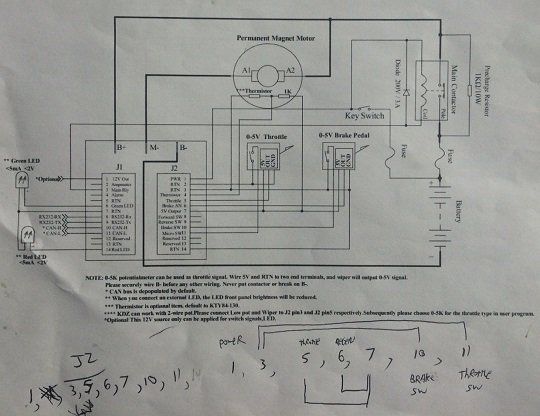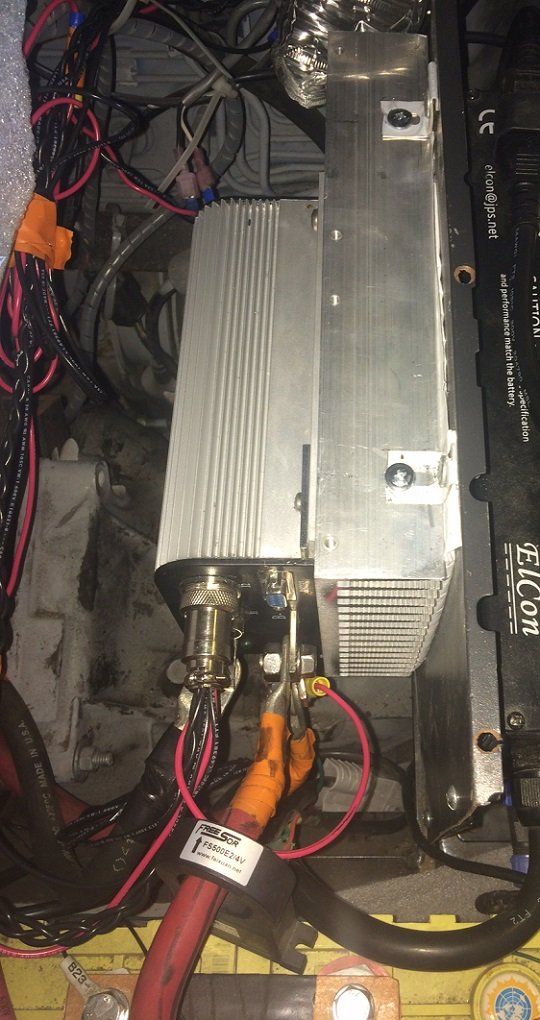Published Wednesday December 24, 2014: Updated May 29, 2015
Adding Regenerative Braking to the Geo EV
Hector, an Electric-vehicle-converting acquaintance of mine, lives in Mexico. He takes the ever popular Volkswagen Beetle and converts it to an all-electric vehicle. They are relatively easy to do because the motor just bolts right on the back of the transmission without needing any other motor mounts.
In October, Hector asked me if I would like to borrow and experiment with a new 550 Amp, 72 Volt Kelly motor speed controller that enables regenerative breaking using a permanent magnet, DC motor.
I was hesitant initially. Although I would love to give the increasingly famous Geo EV the ability to harness wasted kinetic and potential energy, I wasn't keen on taking the risk of breaking something that what was working just fine.
But Hector was persistent. "John, do it for Science" he said. And so I agreed to borrow his controller and experiment with it, "when I had some time."
After work on Friday, (12/5/2014, exactly two years to the day since I first drove the Geo EV on lithium battery power), I was on the way to the post office to pick up the controller that Hector mailed to me and which had just arrived. At a green traffic light, I romped on the throttle a little harder than I normally do, (but not any harder than I had done hundreds of times before). As the Geo was passing 45 mph and as dumb luck would have it, the Geo's 400 Amp motor controller blew out.
“ARE YOU KIDDING ME? This did not just really happen!!! I did not just blow up a 3-year old speed controller on the way to picking up a new speed controller."
I coasted out of traffic and turned onto a side street. Upon popping the hood, I smelled fried MOSFETs. "DANG!!!"

I don't know why the controller blew up. Perhaps it was some latent damage caused by some welding that was done on the car a few months earlier when I neglected to disconnect the main battery terminal before hand? Who knows?
I called Cheryl to come give me a tow home. She arrived in her Nissan Leaf and we potentially made history when her electric car towed my electric car.

As far as towing is concerned, of all the vehicles to tow another car, being pulled by an EV is the most pleasant! No smelly exhaust, no hot exhaust pipes burning through the tow rope and only super smooth accelerations with almost no jerkiness in the rope. The 3.5 mile trip back home went well, without any other problems.
The next day, I took out the bad controller. I could see at least 3 blown transistors but sadly because of the potting, I could not get at them to remove and replace them. My old trusty Alltrax 400 Amp controller was done.
My “maybe-I’ll-get-to-it-when-I-have-time” controller project quickly became my #1 priority.
Luckily, I had the whole weekend to retrofit the Geo with a new controller before I had to go back to work. Fortunately the old and new controllers were fundamentally similar and only differed by a few discrete control/indicator lines.

Late that afternoon, after studying the schematics for the Kelly Controller, I built up the wiring harness, installed it and mounted the new controller to where the old one used to be. The whole project went much more quickly than I thought it would.

Differences:
This 550 Amp Kelly controller requires all 3 terminals on a pot vs just 2 for the old controller. Using a voltage divider circuit, it won't work unless it has all 3.
I opened up the throttle pot box and soldered another wire to the unused 3rd terminal. These three wires go to 3 pins in the controller: 5V, throttle and ground. I inadvertently wired them up backwards. This made the controller error out with a high-throttle-pot state, unless I maxed out the throttle. That caused the motor to just barely spin at max throttle and spin at max RPM when the throttle was not being pushed at all. Oops. Swapping 5V and ground wires going to the pot fixed that.
I also made use of the double throw micro-switch on the pot-box assembly. Pushing on the throttle would engages the switch and indicate that the throttle was in use. Letting off of the throttle, the normally closed position would engage and tell the controller to start regenerative breaking.

After wiring it all up, it took it out for a spin. Let me tell you that, "Regen is AWESOME!"
But then I tried shifting gears. After letting off the throttle, the regen kicked in, which stopped the motor from spinning and I could not get the shifter to fall into the next gear. Yikes! "This will not do!"
I got around this by wiring in a second switch that I had lying around (a momentary push button one) that I can push only when I want regen to kick in. In this manner, I can shift gears while the motor freewheels and engage regen when I'm good and ready for it.

I call this button the “retro-rockets”. ;) Wouldn't it look cool mounted on the stick-shift or steering wheel?
Here is a video showing how regenerative braking works in the Geo. Also, check out how to shift gears, clutch-less. In an electric car, it's so easy, even a 6-year-old can do it!
How to Shift Gears In an Electric Car?
This Kelly Controller is also software configurable. I downloaded the software for free from Kelly Controls.

Using the software, you can adjust view or modify several parameters:
Throttle start/stop position, (I believe this will allow you to use any junk-drawer pot lying around instead of an $18 proprietary one).
Max motor current
Over/Under Voltage
Safety features
Reverse (for direct drive/transmission-less applications)
Regen aggressiveness and different regen modes
Temperature monitoring
I configured the controller to how I like it, (lots of control and high torque). Let me tell you, it is AWESOME! With 550 Amps at my disposal, it has more power and better acceleration than the old 400 Amp controller. Even though this new Kelly controller is much smaller in size, it doesn't run hot at all. The motor does get hot when you push it hard, but that's to be expected from such a tiny motor.
I owe Hector a new controller because this one's a keeper.
I still plan on tweaking things further as time goes on.
Things to Figure Out Still:
- The top speed is only 65 mph, about 3-5 mph lower than what it was with the old controller. I don't know why yet.
- While the "retro-rockets" button is super cool, I would rather it be tied to the brake pedal so it kicks in instinctively every time you want to slow down. This would also illuminate the brake lights and alert the drivers behind me that I am slowing down.
- In 2nd gear, regen is too strong and you slow down too quickly.
- When going down a hill or when carrying a lot of weight, regen is not aggressive enough and I have to use the normal hydraulic friction brakes as well. What a WASTE!
- It would be nice to add potentiometer so as to control the aggressiveness of the regen on demand.
Regenerative braking is motor RPM dependent. At high RPM, and at 50% regen, (the highest setting that the software allows), the motor, (turned generator), delivers upwards of 100 Amps at 80 volts, (~8000 watts), back into the battery pack. As the RPM decreases, the regenerative current goes down. Once the current reaches about 10 Amps, regen shuts off. In 2nd gear, this happens around 5 mph. In 5th gear this happens around 16 mph. So you still need to use the regular brakes for the last few mph before you come to a complete stop.
EVs are So SIMPLE!
Simplicity is native to an electric car. There are far fewer opportunities for failure.
As someone who has always worked on his own cars, I LOVE how easy electric cars are to maintain. An electric motor is 150 times less complicated than a gas engine. They don't require all that mechanical complexity, high operating temperatures and corrosive/toxic/flammable fluids. They only have 1 moving part and it may last for millions of miles.
Commercially made electric cars don’t come with a maintenance manual, only a maintenance pamphlet. You rotate the tires and add washer fluid. Occasionally you may have to lubricate a squeaky door hinge or something.
The garage no longer reeks of gas and oil fumes. The floor of our garage has never been so clean and oil free either. I could get used to this.

Our clean floored, sweet smelling garage.

